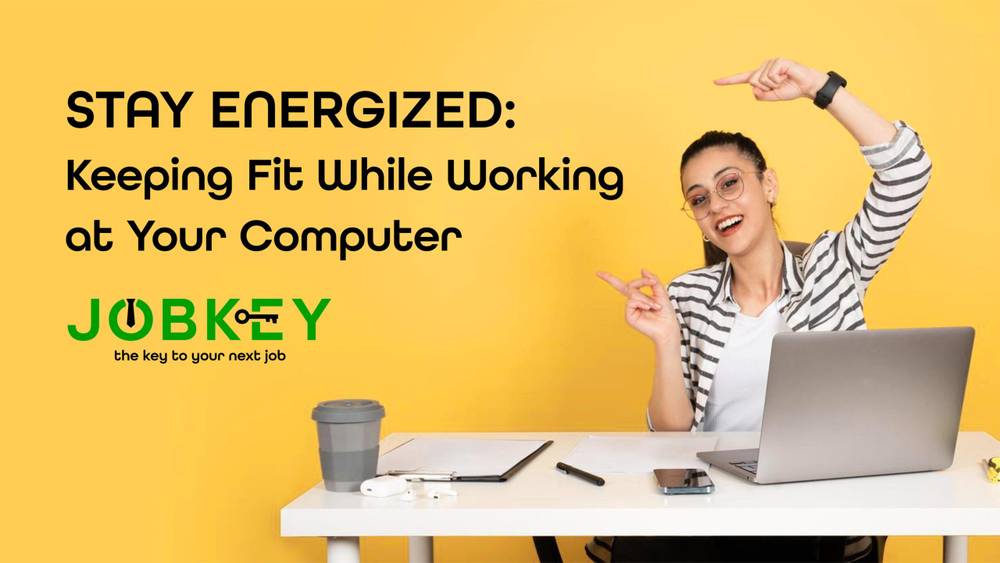
Do you find yourself feeling sluggish and sedentary after spending long hours confined to your desk? The rigors of a typical 40-hour work week can leave little time for self-care, taking a toll on both your physical vitality and mental well-being. If you’re seeking practical solutions to combat this lethargy and infuse your workday with energy and vigor, look no further.
In this guide, we present a range of exercises designed specifically for the workplace environment, ensuring that you can stay active and engaged right from the comfort of your desk. Whether you’re stationed in a traditional office setting or working remotely from home, these simple yet effective workout routines will revitalize your body and sharpen your focus, enhancing both your productivity and overall sense of well-being.
So, bid farewell to the lethargy of sedentary workdays and prepare to embark on a journey of revitalization and renewed vitality. With these desk-friendly exercises at your disposal, you’ll be well-equipped to conquer the challenges of the workday and emerge feeling energized, focused, and ready to tackle whatever tasks lie ahead.
Understanding the Importance of Physical Activity:
As individuals navigate the demands of a typical 9 to 5 desk job, they often find themselves tethered to their desks for prolonged periods. While this may serve to meet financial obligations, the sedentary nature of such a lifestyle can have detrimental effects on overall health, predisposing individuals to various diseases and health complications. Among these potential health risks are:
Cancer: Prolonged sitting has been linked to an increased risk of certain types of cancer, including colon and breast cancer.
Diabetes: Lack of physical activity can contribute to insulin resistance and elevated blood sugar levels, increasing the risk of type 2 diabetes.
Arthritis: Sedentary behavior can exacerbate joint stiffness and inflammation, leading to the development or worsening of arthritis symptoms.
Dementia: Studies have shown a correlation between physical inactivity and cognitive decline, potentially increasing the risk of developing dementia later in life.
Strokes: Sedentary lifestyles are associated with elevated blood pressure and cholesterol levels, both of which are significant risk factors for strokes.
Recognizing the importance of combating the sedentary nature of office life, many health experts advocate for integrating regular physical activity into daily routines. The current recommendation of at least 150 minutes of moderate exercise per week serves as a benchmark for promoting overall health and mitigating the risks associated with prolonged sitting.
For those with demanding schedules that leave little time for traditional gym workouts or fitness classes, incorporating moderate workplace exercises offers a convenient and effective solution. By engaging in simple exercises tailored to the office environment, individuals can break free from the shackles of sedentary behavior and promote both physical and mental well-being.
Here are some expanded exercise ideas for staying active at your desk:
Desk Push-ups: Place your hands on the edge of your desk, shoulder-width apart. Lower your chest toward the desk, then push back up to the starting position. This exercise targets your chest, arms, and core muscles.
Chair Squats: Stand in front of your chair with your feet hip-width apart. Lower your hips back and down as if sitting in the chair, then stand back up. Repeat for a set number of repetitions to work your leg muscles.
Leg Extensions: Sit upright in your chair with your feet flat on the floor. Extend one leg straight out in front of you, then lower it back down. Alternate legs for a set number of repetitions to target your quadriceps and improve leg strength.
Seated Leg Lifts: Sit tall in your chair with your feet flat on the floor. Lift one leg off the ground, keeping it straight, then lower it back down. Switch to the other leg and repeat for a set number of repetitions to engage your core and leg muscles.
Desk Dips: Sit on the edge of your desk with your hands gripping the edge behind you. Walk your feet forward until your knees are bent at a 90-degree angle. Lower your body by bending your elbows, then push back up to the starting position to work your triceps and shoulders.
Desk Planks: Place your hands on your desk shoulder-width apart and walk your feet back until your body forms a straight line from your head to your heels. Hold this position for 30-60 seconds to engage your core and improve stability.
Wrist Stretch: Extend one arm in front of you with your palm facing down. Use your other hand to gently pull back on your fingers until you feel a stretch in your wrist and forearm. Hold for 15-30 seconds, then switch arms.
Neck Rolls: Sit tall in your chair and slowly tilt your head to one side, bringing your ear toward your shoulder. Hold for a few seconds, then roll your head forward and to the other side, completing a full circle. Repeat in the opposite direction to release tension in your neck and shoulders.
Seated Spinal Twist: Sit upright in your chair and cross one leg over the other, placing your opposite hand on the outside of your bent knee. Twist your torso toward the bent knee, using your other hand to hold onto the back of your chair for support. Hold for 15-30 seconds, then switch sides to stretch your spine and improve flexibility.
Ankle Circles: Sit tall in your chair and extend one leg straight out in front of you. Rotate your ankle in a circular motion, first clockwise and then counter clockwise. Switch legs and repeat to improve ankle mobility and prevent stiffness.
The concept of workplace exercise underscores the idea that even amid a busy 40-hour workweek, dedicating just a few minutes each day to exercise at your desk can yield remarkable benefits for your overall health and well-being. By integrating simple physical activities into your work routine, you can experience a range of positive outcomes that contribute to your overall vitality and productivity.
Here are some of the key benefits associated with incorporating exercise into your desk-bound workday:
Improved Physical Fitness: Engaging in desk exercises helps to increase your heart rate, strengthen muscles, and improve flexibility and range of motion, contributing to your overall physical fitness.
Enhanced Mental Clarity: Physical activity stimulates blood flow to the brain, leading to increased mental alertness, focus, and cognitive function, helping you stay sharp and productive throughout the day.
Reduced Stress Levels: Exercise triggers the release of endorphins, neurotransmitters that promote feelings of relaxation and well-being, helping to alleviate stress, tension, and anxiety often associated with workplace pressures.
Boosted Energy Levels: Taking short breaks for desk exercises can help combat feelings of fatigue and lethargy, providing a natural energy boost to help you stay alert and energized throughout the workday.
Improved Posture and Ergonomics: Desk-based exercises that target core muscles and promote proper alignment can help alleviate muscle tension and improve posture, reducing the risk of discomfort and injury associated with prolonged sitting.
Increased Productivity: Regular exercise breaks can enhance productivity by providing a mental and physical reset, allowing you to return to tasks with renewed focus, motivation, and efficiency.
Enhanced Mood and Morale: Exercise releases feel-good hormones like serotonin and dopamine, which can elevate mood, enhance self-esteem, and foster a positive outlook, creating a more enjoyable and rewarding work environment.
Promoted Work-Life Balance: Incorporating exercise into your workday allows you to prioritize your health and well-being without sacrificing professional obligations, helping you achieve a better balance between work and personal life.
Incorporate these fantastic exercise ideas into your daily routine can help you stay active and energized while working at your desk. Remember to listen to your body and take breaks as needed to prevent fatigue or discomfort.





